Affordable & Delicious: Budget-Friendly Stir-Frying
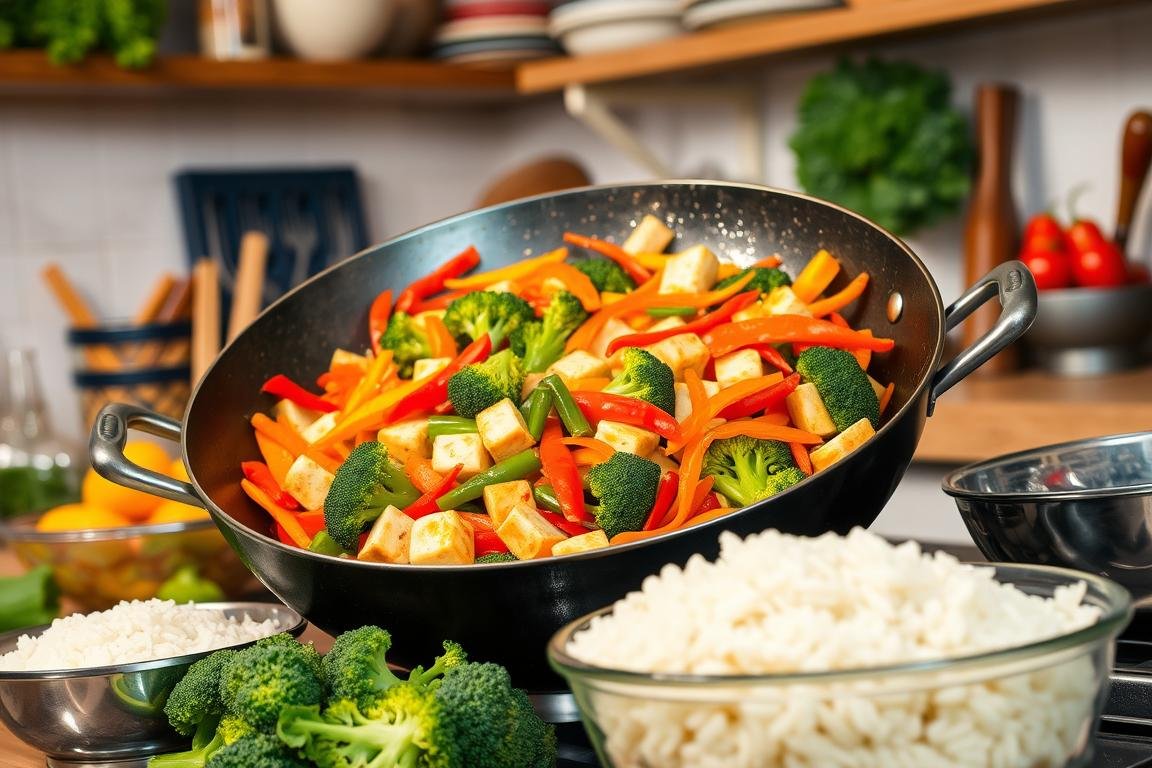
Ever wondered how to whip up a restaurant-quality stir-fry without the restaurant price tag? Can your kitchen recreate the vibrant, crunchy, and flavorful experience of a gourmet stir-fry with just what’s already in your fridge or freezer? Discover how stir-frying on a budget can bring out the thrifty chef in you, turning simple ingredients into affordable stir-fry dishes that are both nutritious and delicious.
Equipped with the right techniques and some creativity, you can master cheap stir-fry recipes. These recipes are quick to prepare and cost pennies on the dollar. Embrace the art of using high heat and the correct pan. This ensures your vegetables and proteins stay crisp and deliciously combined. With a few customizable sauces, even simple budget-friendly stir-fry meals can taste amazing. It’s about making the most of what you’ve got. This transforms the ordinary into something extraordinary.
Key Takeaways
- Understand how to create delectable meals through cost-effective stir-frying techniques.
- Learn to pick ingredients that are both affordable and flavorful for your stir-fry dishes.
- Discover the secrets to keeping your vegetables vibrant and crisp during cooking.
- Explore how to customize a basic brown sauce for a variety of tasty stir-fry meals.
- Gain practical insights into preparing a quick and easy dinner on a budget.
The Fundamentals of Stir-Frying on a Budget
Stir-fry is a quick, nutritious way to cook. It lets you make tasty meals that don’t cost much. You just need to know the basics of this cooking method.
Choosing Cost-Effective Ingredients
For a cheap stir-fry, pick bright veggies and affordable proteins. Buy vegetables like onions and broccoli in bulk. They’re full of flavor and good for you. Chicken, tofu, and sometimes beef or pork are great proteins. Buy them on sale and save for later. This way, your stir-fry will taste great and save you money.
Essential Equipment for Budget Stir-Frying
You need the right tools for stir-frying. A good wok or big skillet is key. If you have an electric stove, get a flat-bottomed wok. It cooks evenly. Choose a non-stick wok to use less oil. This makes meals healthier and saves money.
Understanding Flavor Profiles and Combinations
For tasty stir-fry, mix flavors well. Use soy sauce, garlic, and ginger as a base. Add rice vinegar and a bit of sugar for depth. A splash of lemon or lime adds zest. This combo makes simple stir-fry ingredients taste amazing. And it’s cheap!
Prep is key for budget-friendy stir-fry. Chop veggies and marinate proteins ahead of time. This makes cooking fast and easy. Keep these tips in mind. They’ll fill you up, keep your taste buds happy, and save money.
Step-By-Step Guide to Budget Stir-Fry
A delicious and cheap stir-fry starts with knowing how to prep and cook. Use frugal stir-fry tips to make meals that are low-cost and yummy. Here’s how to get great results without spending a lot.
Preparation of Ingredients: A Key to Efficiency
Being quick is key for a stir-fry. Get all your tools and ingredients ready. You need a sharp knife to chop veggies well. This makes them cook evenly.
Cut things like carrots and broccoli small. They take longer to cook. But mushrooms and peppers can be bigger because they cook fast.
Mastering the Stir-Fry Technique
Getting the pan hot is important. Add some toasted sesame oil before anything else. Start with meat or tofu, then add hard veggies.
Put in a bit of soy sauce for flavor. Keep stirring to cook everything well. This cooks food fast, keeps flavors, and saves nutrients. It’s a top money-saving move.
Adapting Recipes to Available Produce
Being flexible helps keep a stir-fry cheap. Use veggies and meat that are on sale or already in your fridge. This cuts down on waste and lets you make a stir-fry that’s both cheap and full of what you like.
The best stir-fry depends on both what and how you cook. Use these easy steps and smart tips to make a stir-fry that’s kind on your budget.
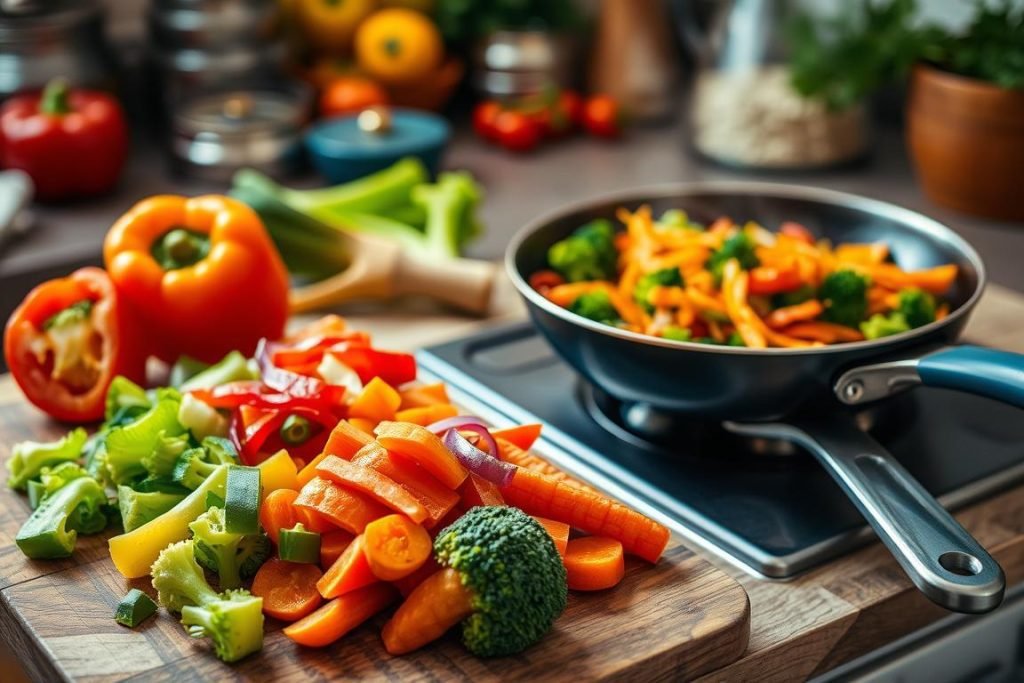
Top Inexpensive Stir-Fry Ingredients That Taste Great
You don’t need to spend a lot for a tasty stir-fry. Choose affordable stir-fry ingredients to save money and enjoy different tastes and textures. This way, your meal is cheap and very tasty.

Shop smart and pick vegetables like broccoli, carrots, and bell peppers. Add mushrooms and sugar snap peas for color and crunch without spending much. Mixing various veggies makes your meal look good and healthy too.
For proteins, cheap options include beef, chicken, or pork. Try shrimp or tofu too. They cook fast and can be flavored with what you have at home. Here’s a guide for a tasty stir-fry that’s easy on your wallet:
| Ingredient Category | Examples | Cost-Efficiency Note |
|---|---|---|
| Proteins | Chicken, Beef, Tofu | Choose bulk packs or sale items to save more. |
| Vegetables | Broccoli, Bell Peppers, Carrots | Purchase seasonal vegetables for freshness and better prices. |
| Sauce Base | Soy sauce, Sesame oil, Rice vinegar | Bulk buy these versatile staples to use in various dishes. |
| Garnishes (Optional) | Sesame seeds, Chili flakes | Small quantities can elevate the dish, so buy sparingly. |
Affordable stir-fry ingredients make for a quick and yummy meal. Stir-frying is fast and keeps your veggies nutritious. Just a quick cook on high heat does it. It’s not just cheap but healthy too.
Creating a Versatile Stir-Fry Sauce on a Shoestring
Learning frugal cooking tips is fun. Especially when you find recipes like a versatile stir-fry sauce. It’s simple and saves money. This sauce makes your meals tasty and low-cost.
Base Ingredients for a Budget-Friendly Sauce
Start with basic things like soy sauce, water, and brown sugar. Add thinly sliced garlic, a bit of sesame oil, and cornstarch to thicken. This mix is savory and a bit sweet. It’s a great start for many stir-fry sauces.
Customizing Your Sauce for Variety
You can change the sauce in many ways. Add sriracha for heat or oyster sauce for deep flavor. Hoisin sauce adds sweetness and tang. Pineapple juice gives a tropical flavor. These changes make your dishes interesting and affordable.
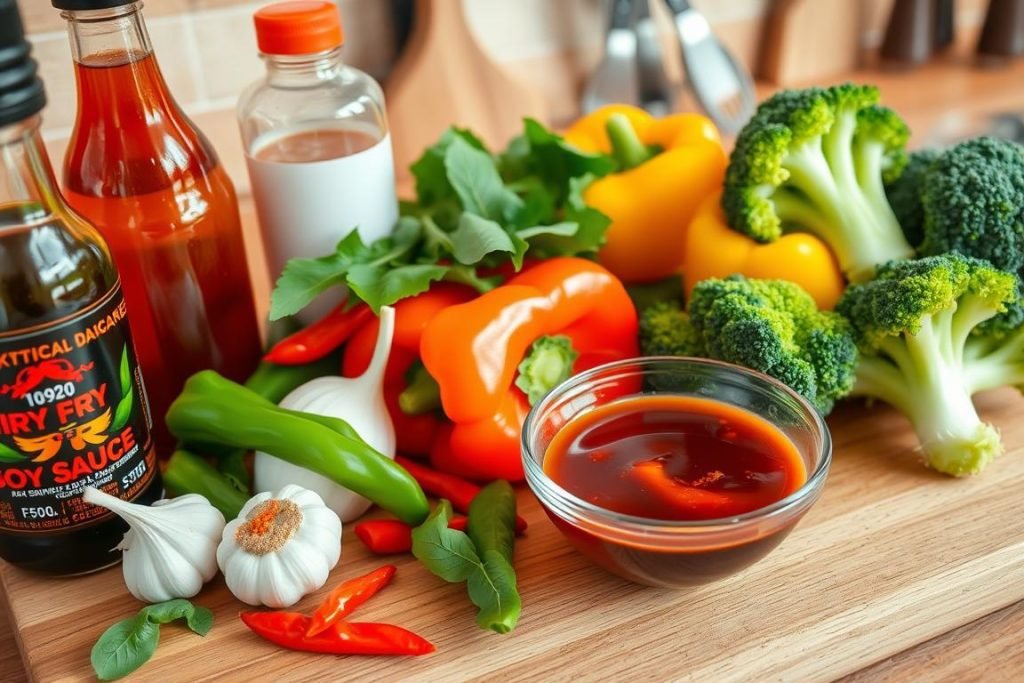
| Ingredient | Base Recipe | Spicy Twist | Sweet and Tangy | Tropical Touch |
|---|---|---|---|---|
| Soy sauce | 1 part | 1 part | 1 part | 1 part |
| Water | 2 parts | 1.5 parts | 1.5 parts | 1 part |
| Brown sugar | 1 part | 0.75 parts | 1.5 parts | 1 part |
| Sesame oil | 2 tsp | 2 tsp | 2 tsp | 2 tsp |
| Garlic, minced | 2 cloves | 2 cloves with chili flakes | 2 cloves | 2 cloves |
| Extra ingredient | – | Add Sriracha to taste | Add hoisin sauce | Add pineapple juice |
With these tips, your dishes will be rich in flavor without costing a lot. A good stir-fry sauce changes your meal plan for the better. You can enjoy fancy tastes on a tight budget. It’s very rewarding.
Healthy Eating: Nutrition Meets Budget in Stir-Fry
Healthy eating and saving money can go hand in hand with stir-frying. It’s a way to eat well and keep costs low. Stir-frying with lean meats, lots of veggies, and smart ways of cooking makes meals better and cheaper.
Benefits of Stir-Frying for a Balanced Diet
Nutritional benefits of stir-frying are huge. It keeps the goodness of fresh foods. Stir-frying uses quick, high heat. This saves nutrients that long cooking can destroy. It also blends flavors well, making tasty meals without too much fat or oil.
Incorporating Lean Proteins and Fibrous Vegetables
Adding lean proteins to stir-fries is great for muscles and doesn’t add extra calories. Use chicken, tofu, or shrimp for good nutrition. Then add fibrous vegetables—like broccoli, peppers, and peas. They add fiber, vitamins, and minerals. These foods fill you up, help digestion, and keep energy up.
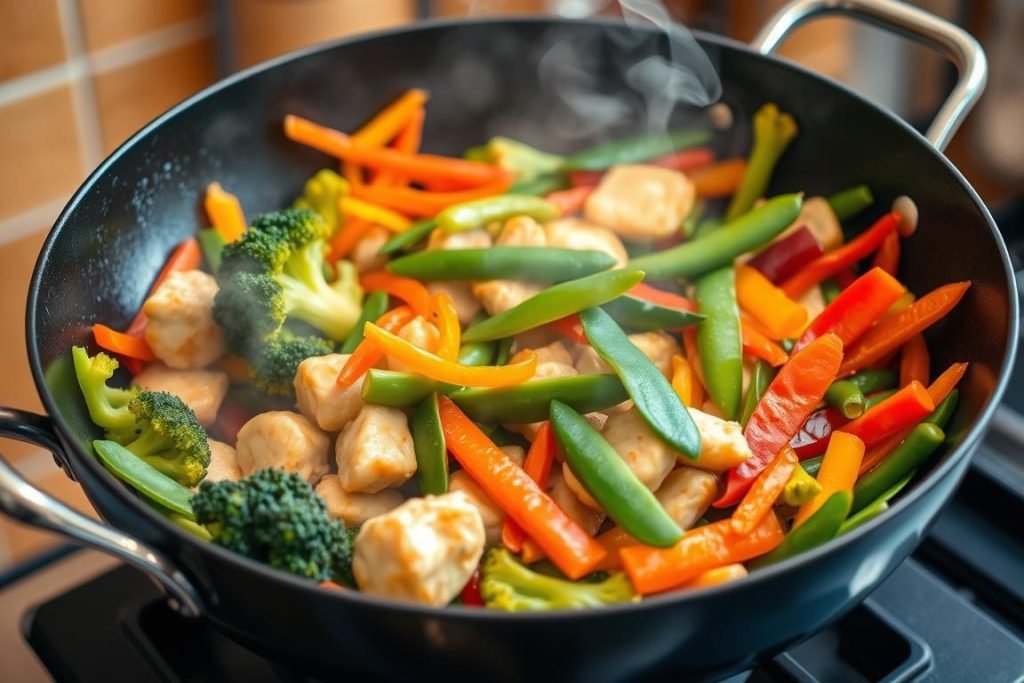
| Ingredient | Protein Content | Fiber Content |
|---|---|---|
| Chicken (100g) | 23g | 0g |
| Broccoli (1 cup) | 2.6g | 2.4g |
| Tofu (100g) | 8g | 1g |
| Snap Peas (1 cup) | 2g | 3.4g |
| Shrimp (100g) | 24g | 0g |
Stir-frying is more than cooking. It’s a way to live healthier without spending a lot. This cooking method helps you enjoy tasty, healthy dishes. It’s good for your health and your pocket.
Clever Cooking: Economical Stir-Fry Hacks
Master clever stir-fry tips to make your kitchen a hub for economical cooking techniques. Stir-frying uses quick, high-heat to keep foods colorful and nutritious. It’s a smart way to cook tasty meals without spending a lot.
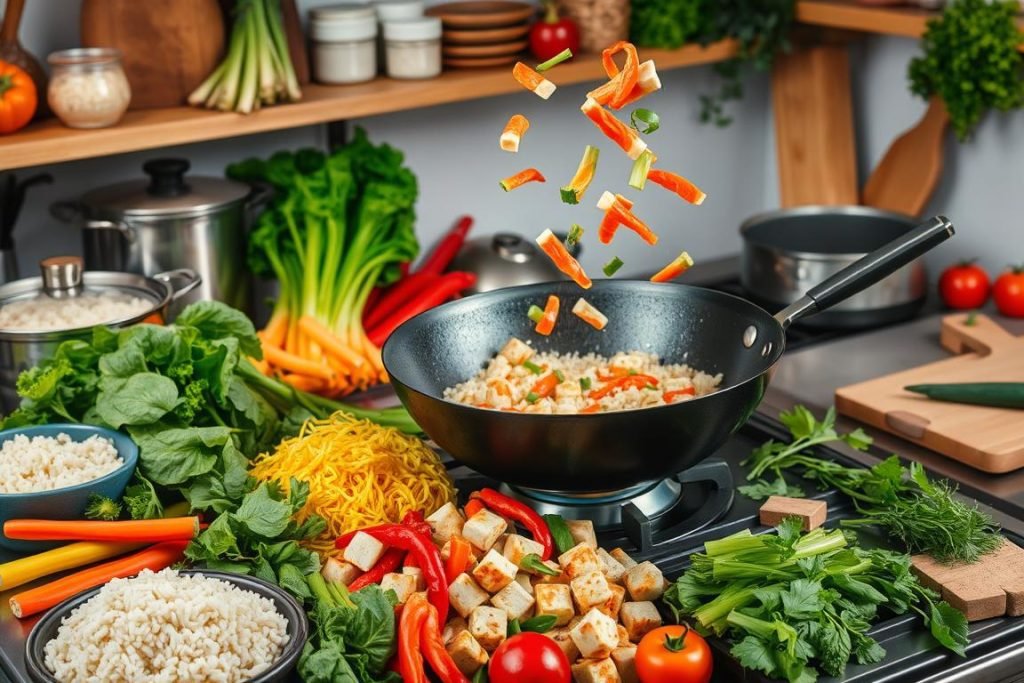
Using leftovers is a key stir-fry hack. Add yesterday’s veggies or chicken to make a new, flavorful meal. This reduces waste and saves money. Here’s how to mix economical cooking techniques into your daily cooking:
- Preheat your pan on medium-high before adding oil and food. This stops moisture from building up.
- Begin with hard-to-cook foods, like root veggies, and add lighter ones or proteins later on.
- Avoid stuffing the pan. Cooking in batches keeps heat high and cooks everything just right.
- Add fast-cooking items like scallions or bean sprouts last for freshness and crunch.
Optimizing how you prepare ingredients is another smart tip. Cutting veggies evenly is key for quick cooking. Use fresh or frozen produce but always cut ahead and store them right.
Hsiao-Ching Chou sees stir-frying as flexible. You can use whatever’s in your fridge. This way, you can enjoy various flavors and save money by using what’s on hand.
To cut costs, try making your own sauces. A bit of soy sauce, sesame oil, and fresh ginger can elevate your dish. This is cheaper than store-bought sauces.
- Keep the heat up to avoid soggy veggies.
- Stir often and serve right away for the best taste and texture.
Using these clever stir-fry tips, you’ll improve your meals in taste, health, and cost. Leftovers become delicious feasts. Simple ingredients turn into exciting dishes. Embrace these adaptable techniques for better stir-frying.
Global Flavors: Cheap Stir-Fry Recipes from Around the World
Learning to stir-fry can really up your cooking game. It lets you make cheap, tasty meals with worldwide flavors. You can try classic Asian stir-fries or dishes from many cultures. All are yummy and easy on the wallet.
Exploring Asian Cuisine: Classic Methods and Ingredients
Asian cooking is smart with ingredients and techniques. Marinating meat and using a hot wok bring out big flavors. For example, pork marinated for hours tastes amazing. Using things like soy sauce, sesame oil, and bok choy makes each dish both cheap and delicious.
Stir-Fry Inspirations from Different Cultures
Multicultural stir-fry recipes are like a delicious trip around the world. They mix unexpected veggies and spices. This lets you try new things without spending a lot. It’s great for cooks who love to explore without going broke.
| Preparation Aspect | Details | Impact on Cost |
|---|---|---|
| Ingredient Uniformity | Cutting all ingredients to similar sizes ensures even cooking. | Reduces cooking time and energy use. |
| Cooking Temperature | Utilize a hot wok or pan for optimal results. | Enhances food flavor, reducing need for additional ingredients. |
| Oil Usage | Selection of high smoke point oils like peanut or grapeseed. | Efficient cooking; less oil used over time. |
| Batch Cooking | Cook ingredients in batches to avoid overcrowding. | Ensures even cooking, saving time and energy. |
These tips help you make multicultural stir-fry recipes affordably. Success comes from both technique and what you use.

Looking for a cheap meal that’s full of culture and taste? Try making a global flavored stir-fry. Your wallet and taste buds will be happy you did.
Affordable Stir-Fry Dishes for Students and Families
Stir-frying is great for family-friendly stir-fry recipes and budget-friendly meals for students. It’s quick and flexible, perfect for busy or low-budget times. You can mix ingredients based on what you like or what’s cheap, making every meal special and easy on the wallet.
Take the Chicken Stir Fry by Marsha McDougal, for example. It’s easy, cheap, and good for you. It’s perfect for students and families looking to save.
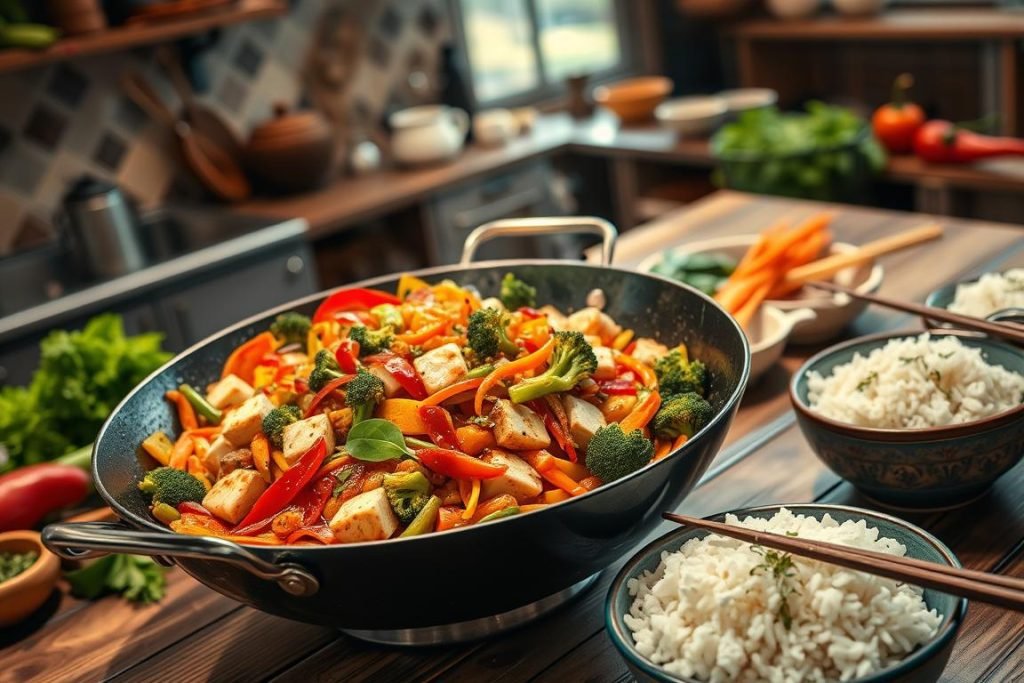
The Chicken Stir Fry is full of good stuff. It has veggies like broccoli, carrots, red bell peppers, and onions. These mix with chicken for tasty, affordable meals.
It’s easy to make in about 30 minutes and you can find everything you need close by. This meal is great for people with a lot to do. Leftovers stay good in the fridge, providing quick meals for days.
- Total Yield: 4 large servings
- Calories per Serving: 691
- Key Ingredients: Marinated chicken, broccoli, carrots, bell peppers, and onions
- Suggested Cooking Time: Under 30 minutes
This stir fry is not just filling. It’s balanced too, with 49g of protein, 75g of carbohydrates, and 22g of fat per serving. It keeps you going, reducing the need to snack.
Our family-friendly stir-fry recipe can change to fit your needs. Play with the veggies and meat amounts or swap ingredients. If you can’t have gluten, try tamari or coconut aminos instead of soy sauce. It makes the recipe work for everyone.
In conclusion, the Chicken Stir Fry shows that simple, cheap cooking can be powerful. It’s flexible, easy, and budget-friendly, making it perfect for everyone whether cooking for one or many.
Shopping Smart: Finding the Best Deals for Your Stir-Fry Ingredients
Smart shopping for stir-fry starts with knowing what and when to buy. This can cut down your food costs. We’ll show you how to shop for seasonal stir-fry ingredients smartly. This way, each meal is not just tasty but easy on the wallet too.
Seasonal Shopping: Buy Produce When It’s Cheapest
Buying vegetables and herbs in their peak season saves money and gives better flavor. For example, broccoli costs less in its peak season. Here’s a quick guide on the best times to buy certain stir-fry ingredients:
- Broccoli: Cheapest in late winter and early spring.
- Red bell peppers: Best prices in summer and early fall.
- Mushrooms: Stable prices year-round, but look for sales in fall.
- Onions and cabbage: Lowest prices in fall and early winter.
Where to Shop: Comparing Grocery Stores, Farmers Markets, and Online
Knowing where to shop helps find the best deals on stir-fry ingredients. Farmers’ markets often have fresher, cheaper produce if you’re buying seasonally. But supermarkets and online stores also offer great deals and promotions.
| Source | Pros | Cons |
|---|---|---|
| Grocery Stores | Year-round availability, frequent sales | May have higher prices for organic produce |
| Farmers Markets | Fresh, locally-sourced, supports local economy | Limited opening days and hours |
| Online Retailers | Convenience, often include reviews and bulk options | Shipping costs, cannot inspect produce physically |

Exploring the world of stir-fry, remember to be smart in your shopping. Mix up where you shop and when you do it. By doing so, your cooking will not only be delicious but also kind to your wallet.
Conclusion
Mastering stir-fry on a budget is easy. You can cook tasty meals without spending much. For example, a $6 bag of frozen chicken breasts from Target shows that. It has 8 to 9 pieces, perfect for many meals.
Use it with a stir-fry mix from Food Lion for a great meal. This way, you eat well and save money.
Stir-fry cooking is smart cooking. Use frozen veggies and chicken with high heat; they taste great. Especially, when you add soy sauce. Add noodles or rice for more filling meals. Also, plan your meals and store ingredients properly. This cuts down waste and costs.
Don’t overlook store brand items, seasonal veggies, and cheap proteins like beans and tofu. With a nonstick skillet or wok, anyone can cook well. Try batch-cooking to save time. Use herbs and spices to make your food taste amazing. Cooking like this saves money and fills your home with lovely smells.
In the end, learning to stir-fry on a budget is rewarding. It shows you can eat well without spending a lot. Plus, it’s good for your wallet and your health.